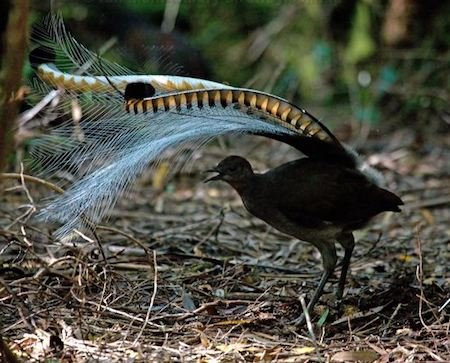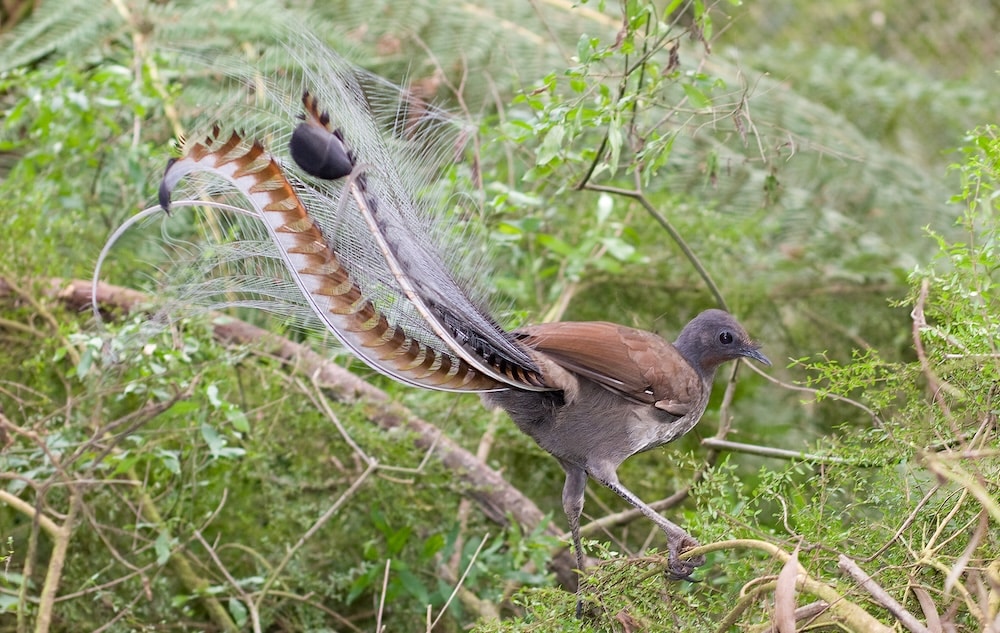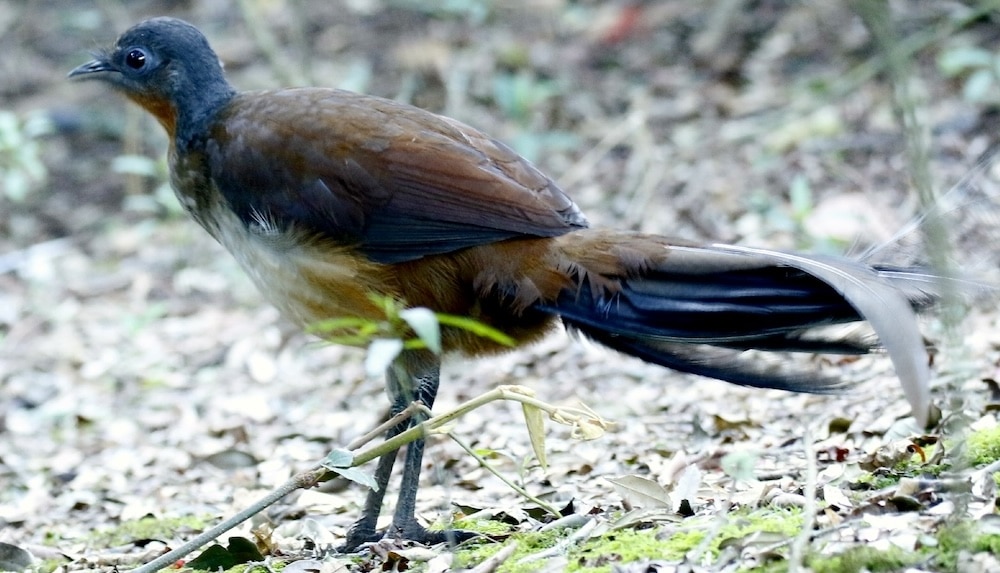Menuridae – Lyrebirds

There are two species of Lyrebird; ground-dwelling Australian birds, that form the genus, Menura, and the family Menuridae. They are most notable for their superb ability to mimic natural and artificial sounds from their environment. Lyrebirds have unique plumes of neutral coloured tail feathers. They are are among Australia’s best-known native birds. As well as their extraordinary mimicking ability, lyrebirds are notable because of the striking beauty of the male bird’s huge tail when it is fanned out in display; and also because of their courtship display. It is generally accepted that the lyrebird family is most closely related to the Atrichornithidae (Scrub-birds) and some authorities have combined both in a single family, but evidence that they are also related to the bowerbirds remains controversial and unproven.
The Superb Lyrebird is found in areas of rainforest in Victoria, New South Wales and south-east Queensland, as well as in Tasmania where it was introduced in the 19th century. Many superb lyrebirds live in the Dandenong Ranges National Park and Kinglake National Park around Melbourne, the Royal National Park and Illawarra region south of Sydney and in many other parks along the east coast of Australia as well as non-protected bushland. Albert’s lyrebird is found in only a very small area of Southern Queensland rainforest.

Superb Lyrebird Menura novaehollandiae – Fir0002/Flagstaffotos via Wikimedia Commons
Lyrebirds are shy and difficult to approach, particularly the Albert’s Lyrebird, which means that there is little information about its behaviour. When lyrebirds detect potential danger they will pause and scan their surroundings, then give an alarm call. Having done so, they will either flee the vicinity on foot, or seek cover and freeze. Firefighters sheltering in mine shafts during bushfires have reported being joined by lyrebirds!
They feed on the ground and as individuals. A range of invertebrate prey is taken, including insects such as cockroaches, beetles (both adults and larvae), earwigs, fly larvae, and the adults and larvae of moths. Other prey taken includes centipedes, spiders, earthworms. Less commonly taken prey includes stick insects, beetles, amphipods, lizards, frogs and occasionally, seeds. They find food by scratching with their feet through the leaf-litter.
The breeding cycle of the lyrebirds is long, and they are long-lived birds; they are known to have lived up to thirty years. They also start breeding later in life than other passerines. Female Superb Lyrebirds start breeding at the age of five or six, and males at the age of six to eight. Males defend territories from other males, and these territories may contain the breeding territories of up to eight females. Within the male territories, the males create or use display platforms; in the case of the Superb Lyrebird, it is a mound of bare soil; in the Albert’s Lyrebird it is simply a pile of twigs on the forest floor.

Albert’s Lyrebird Menura alberti – ©TonyCastro CC BY-SA 4.0 via Wikimedia Commons
Male lyrebirds call mostly during winter, when they construct and maintain an open arena-mound in dense bush, on which they sing and dance in courtship, to display to potential mates, of which the male lyrebird has several. The female builds an untidy nest, usually low to the ground in a moist gully, where she lays a single egg. She is the sole parent who incubates the egg over 50 days until it hatches, and she is also the sole carer of the lyrebird chick.
A lyrebird’s song is one of the more distinctive aspects of its behavioural biology. Lyrebirds sing throughout the year, but the peak of the breeding season, from June to August, is when they sing with the most intensity. During this peak they may sing for four hours of the day, almost half the hours of daylight. The song of the Superb Lyrebird is a mixture of seven elements of its own song and any number of other mimicked songs and noises. They are incredible mimics and when close to habitation they have incorporated all sorts of sounds from the human world such as chain-saws, crying babies, car alarms, rifle fire and even mobile phones!
The lyrebirds are large passerine birds, amongst the largest in the order. They are ground living birds with strong legs and feet and short rounded wings. They are generally poor fliers and rarely take to the air except for periods of downhill gliding. The Superb Lyrebird is the larger of the two species. Females are 74cm–84cm long, and the males are a larger 80cm–98cm long—making them the third-largest passerine bird after the Thick-billed Raven and the Common Raven. Albert’s Lyrebird is slightly smaller at a maximum of 90cm (male) and 84cm (female). They have smaller, less spectacular lyrate feathers than the Superb Lyrebird, but are otherwise very similar.
-
Number of bird species: 2
(As at November 2025)
According to the recently (2025) amalgamated AviList, there are just two species, in one genus in the Menuridae family. They are:
Albert’s Lyrebird Menura alberti
Superb Lyrebird Menura novaehollandiae
Given that this is a tiny family with just two species in a single genus, Fatbirder provides active links below to both species.
-
Albert's Lyrebird Menura alberti
Species AccountA large brown bird with very long tail; the male's is said to be lyre-shaped. These curved outer tail feathers are absent in juveniles and females... -
Albert's Lyrebird Menura alberti
Species AccountAlbert's lyrebird (Menura alberti), also known as Northern lyrebird, is a timid, pheasant-sized songbird which is endemic to subtropical rainforests... -
Albert's Lyrebird Menura alberti
Species AccountSound archive and distribution map. -
Superb Lyrebird Menura superba
Species AccountThe Superb Lyrebird looks like a large brown pheasant. The wings are rufous in colour and the bill, legs and feet are black... -
Superb Lyrebird Menura superba
Species AccountThe Superb Lyrebird (Menura superba) is chicken-sized and rather nondescript, but males have a unique tail containing three types of feathers, which in certain positions resembles a lyre. The outermost feathers are broad and curled, enclosing a dozen filamentous, gauze-like feathers and two very long, tapered, and curled plumes totaling 16 feathers. Females have a long tail, but they barely show signs of the developments found in males. Lyrebirds feed on insects, myriapods and snails… -
Superb Lyrebird Menura superba
Species AccountSound archive and distribution map.
-
Albert's Lyrebird Menura alberti
VideoU-Tube video of feeding Alberts Lyrebird... -
Superb Lyrebird Menura superba
VideoSuperb Lyrebird (Menura novaehollandiae) in the bush near the Fitzroy Falls Morton National Park Southern Highlands of New South Wales Australia October 2012... -
Superb Lyrebird Menura superba
VideoYou-Tube footage of feeding lyrebird...
